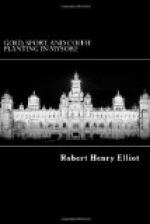I turn, lastly, to the consideration of a disease in coffee which is popularly known by the name of rot, and scientifically as pellicularia koleroga, a fungoid plant which crawls over the leaves and seals up their breathing pores, till at last the leaf dies, as man does, from want of breath. On one of my estates we have had a considerable experience of it, and, whatever may cause rot, I feel sure that what aggravates it, and causes it to be very injurious, is the want of free circulation of air over the land, and through the coffee trees; and I am the more convinced of this because we have found rot worse in the open, and where there was little undecayed vegetable matter present in the soil, than in rather thick shade with abundance of undecayed vegetable matter on the surface. But in the latter case the land is on a rather high ridge exposed to the constant winds of the south-west monsoon, while in the former case the land was in a hollow under a hill which lies between it and the west—a hollow completely sheltered from the wind. And it is in such sheltered spots that we find rot worse, and quite independently of the presence or absence of shade or of vegetable matter lying on the land. To check rot, then, the free circulation of air is necessary both over the land and through the plant. Much may be done in the first case by judiciously opening channels for air through the shade trees so as to admit a free circulation of air into hollows, and much in the latter by freely handling out the centres of the trees which, in the monsoon, and especially in hollows, are apt to grow a superabundance of young wood, which chokes up the centre of the tree and thus hinders the free circulation of air. The soil, too, is often excessively saturated in these hollows, and, where this is the case, the land should be surface drained. Though I have not as yet adopted the plan of sweeping up and putting into the manure heap, or burying with a little lime added, the numerous dead leaves that are apt to drift into hollows, I feel sure that either of these plans would be attended with advantage, by lessening damp, and allowing a free circulation of air over the land. I am confident, I may add here, that the removal of the lower branches of the coffee trees, branches which in any case bear hardly anything in well-shaded land, would be of great advantage in lessening the damp in the plantation, and so diminishing the causes that promote rot.
With reference to rot, it is of great importance to thin out young wood as early as possible, so that, when the rot season arrives, the trees may have a moderate amount of well-matured young wood, with fully-developed hardened leaves, instead of a largo number of small succulent shoots covered with succulent leaves, which are very apt to be rotted bodily away. And the importance of this is equally great with reference to leaf disease, and Mr. Ward, in his “Report” (p. 15), points out that pruning and manuring should




